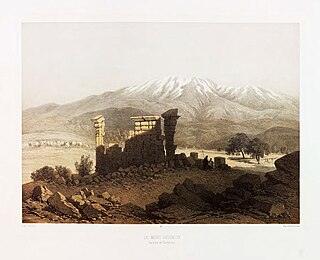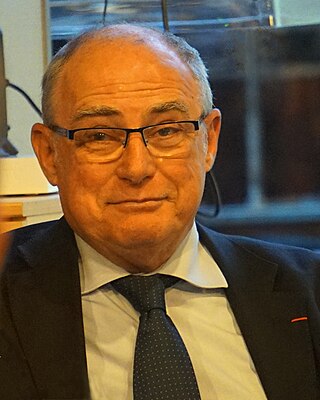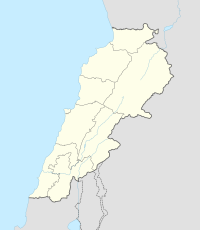
Numa Denis Fustel de Coulanges was a French historian. Joseph M. McCarthy argues that his first great book, The Ancient City (1864), was based on his in-depth knowledge of the primary Greek and Latin texts. The book argued that:

Saint Joseph University of Beirut is a private catholic research university located in Beirut, Lebanon, which was founded in 1875 by French Jesuit missionaries and subsidized by the Government of France during the time when Lebanon was under Ottoman rule. It is widely recognized as one of the leading and most prestigious academic institutions in Lebanon and Middle East. The institution boasts a diverse and accomplished group of alumni, who have gone on to become leading figures in politics, law, academia, literature, sciences, arts, medicine, and religion. USJ's impressive roster of graduates includes seven of Lebanon's fourteen Presidents, a Speaker of the Parliament of Lebanon, two Presidents of the Council of Ministers of Lebanon, hundreds of legislators and ministers, numerous judges, and high-ranking civil servants, among them Commanders of the Lebanese Armed Forces and executives of the Internal Security Forces. As the oldest and foremost French university in Lebanon, it not only promotes Lebanese culture but also upholds a policy of equal admission opportunity without consideration of ethno-religious affiliations. Furthermore, it advocates trilingual education, offering instruction in French, Arabic, and English. Additionally, it is known in Lebanon and the Middle East for its prominent university hospital, the Hôtel-Dieu de France, and for its prestigious and historical Faculty of Law, modern Lebanon's oldest law school and the first law school in Lebanon since the ancient Roman law school of Berytus.

Rashaya, Rachaya, Rashaiya, Rashayya or Rachaiya, also known as Rashaya al-Wadi or Rachaya el-Wadi, is a town of the Rashaya District in the west of the Beqaa Government of Lebanon. It is situated at around 1,200 metres (3,900 ft) above sea level on the western slopes of Mount Hermon, south east of Beirut near the Syrian border, and approximately halfway between Jezzine and Damascus.

The Greek community in France numbers around between 35,000 - 50,000 people. They are located all around the country but the main communities are located in Paris, Marseille and Grenoble.
Claude Calame is a Swiss writer on Greek mythology and the structure of mythic narrative from the perspective of a Hellenist trained in semiotics and ethnology (ethnopoetics) as well as philology. He was a professor of Greek language and literature at the University of Lausanne and is now Director of Studies at the School for Advanced Studies in the Social Sciences, in Paris.- He taught also at the Universities of Urbino and Siena in Italy, and at Yale University in the US.

Kaukaba, Kaukabet El-Arab or Kaukaba Station is a village in the Hasbaya District in the Nabatiye Governorate in southern Lebanon.
Neba'a Faour, Tell Neba'a Faour, Mashna'et el Faour, Neba Faour or Nebaa Faour is a large, low-lying archaeological tell mound in the Bekaa Valley, Lebanon inhabited in the late 7th and early 6th millennium BC. It was initially discovered by Lorraine Copeland and Peter J. Wescombe in 1965 near the road from Beirut to Damascus, 5 miles from the border with Syria. The site was mainly composed of soil and pebbles on limestone bedrock, the site showed heavy erosion since it was abandoned and recent damage from modern construction in the area. It has been suggested as an example of an aceramic stage following the Pre-Pottery Neolithic B (PPNB) that is called the Pre-Pottery Neolithic C (PPNC); sites of comparable culture are Tell Ramad, Labwe and others in the Byblos region. It is generally dated between the second half of the 7th millennium and the beginning of the 6th millennium BC.
Deir El Aachayer is a village north of Rashaya, in the Rashaya District and south of the Beqaa Governorate in Lebanon.
Reverend Father Auguste Bergy was a French Jesuit archaeologist known for his work on prehistory in Lebanon.

Aaiha is a village, plain, lake, and temporary wetland situated in the Rashaya District and south of the Beqaa Governorate in Lebanon. It is located in an intermontane basin near Mount Hermon and the Syrian border, approximately halfway between Rashaya and Kfar Qouq.
Kefraya is a village in the Western Beqaa District of the Beqaa Governorate in the Republic of Lebanon, approximately 7 kilometres (4.3 mi) northwest of Joub Jannine. The village is home to a mixed population of Sunnis and Greek Catholics.

Nebi Safa, Nabi Safa, Neby Sufa, An Nabi Safa, An Nabi Safa' or En Nabi Safa also known as Mazraet Selsata or Thelthatha is a village in the Kfar Mishki municipality situated 13 kilometres (8.1 mi) west of Rashaya in the Rashaya District of the Beqaa Governorate in Lebanon.

Ain Aata, Ain Ata, 'Ain 'Ata or Ayn Aata is a village and municipality situated southwest of Rashaya, 99 kilometres (62 mi) south-east of Beirut, in the Rashaya District of the Beqaa Governorate in Lebanon.
Pierre Amandry was a French hellenist, especially interested in ancient Greece and its relationships with south-west Asia. He was born at Troyes on December 31, 1912, and died in Paris on February 21, 2006. A large part of his work was on the site of Delphi, excavated by the French School at Athens, of which he was secretary general from 1941 to 1948 and director from 1969 to 1981.
Ernest Louis Georges Will was a 20th-century French archaeologist and University professor, a member of the Académie des Inscriptions et Belles-Lettres.
Dominique Charpin is a French Assyriologist, professor at the Collège de France, and corresponding member of the Académie des Inscriptions et Belles-Lettres, specialized in the "Old-Babylonian" period.

Maurice Sartre is a French historian, an Emeritus professor of ancient history at the François Rabelais University, a specialist in ancient Greek and Eastern Roman history, especially the Hellenized Middle East, from Alexander to Islamic conquests.
Bernard Heyberger is a French historian. He specializes in the history of Middle Eastern Christianity from the sixteenth century to the present; modern Catholicism and Catholic missions; and the Arab provinces of the late Ottoman Empire, especially Syria. He is a Director of Studies at the École des Hautes Études en Sciences Sociales (EHESS) in Paris, and simultaneously holds a chair as Director of Studies in the Religious Sciences section at the École Pratique des Hautes Études (EPHE), also in Paris.
The Bibliothèque Orientale is a large research library founded in 1875 by the Jesuits of the Saint Joseph University in Beirut, Lebanon. In 2014, it held more than 225,000 books, 250,000 photographs and various documents in the fields of archaeology, theology, history, geography, philosophy, linguistics, literature and art.










